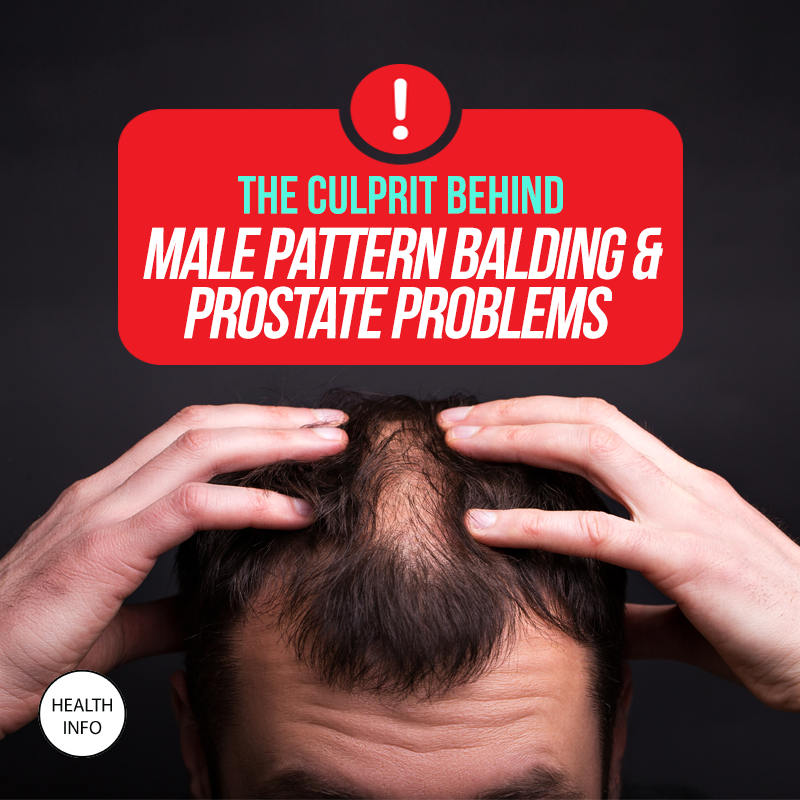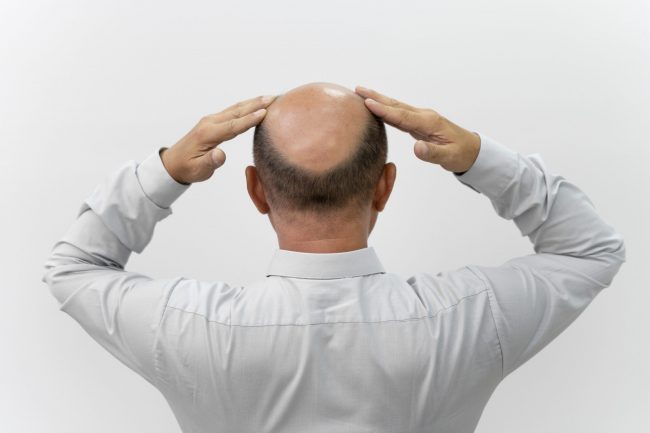- Home
- Health Center
- Health Info
- The Culprit Behind Male Pattern Balding & Prostate Problems
The Culprit Behind Male Pattern Balding & Prostate Problems


Did you know? Male pattern baldness and prostate problems can be linked to the same culprit: dihydrotestosterone! Before we talk about what dihydrotestosterone is, let’s find out more about male pattern baldness and prostate problems.
Male Pattern Baldness
Male pattern baldness, also called androgenic alopecia, is the most common type of hair loss in men. This type of baldness usually occurs at the crown and the temple area of men’s hair. This will result in the ‘M-shape’ baldness seen mainly in men.
Prostate Problems
The prostate is a small gland that is located just below the bladder in men that helps make semen.
As men age, the prostate gets larger. This will potentially lead to the condition called Benign Prostatic Hyperplasia (BPH) where the prostate squeezes on the urethra, the tube that carries urine and semen out of the penis.
The squeezing of the urethra will cause several of the following symptoms:
- Dribbling when finish urinating
- A hard time to start urinating
- A weak urine stream
- Feeling the need to pee just after urinated
- Having to go urinating frequently in a day
- Incontinence – unintentional passing of urine
- Sudden need to urinate
- Waking up several times in a night to urinate
Benign Prostatic Hyperplasia is not the only prostate problem occurring among the men. Prostate cancer can also occur when cancer cells form in the prostate.
The Culprit: Dihydrotestosterone
Dihydrotestosterone (DHT) is a sex hormone that is involved in the development of male sex characteristics such as facial hair and body hair.
Men have much higher levels of the male hormone testosterone in the body than women. The body converts about 10% of testosterone into dihydrotestosterone (DHT) each day.
High levels of DHT shrink the hair follicles and shorten the hair growth cycle, resulting in hair loss.
On the other hand, DHT is involved in the prostate development in males during puberty. As men age, the prostate continues to grow under the influence of DHT. This will lead to benign prostatic hyperplasia.
A fun fact, the women do not have a prostate due to the difference in hormonal levels between men and women.
Dihydrotestosterone VS Testosterone
Do not confuse Dihydrotestosterone with Testosterone. Testosterone is more abundant in a man’s body than dihydrotestosterone. Testosterone is involved in preserving muscle mass (which leads to higher strength). Testosterone also affects sperm production.
Similar to Testosterone, Dihydrotestosterone has an impact in physiological features of men. However, dihydrotestosterone is actually more potent than testosterone.
Now You Know!
DHT is the reason why the ‘M-shape’ balding occurs mainly in men. DHT is also the reason behind the development and the enlargement of the prostate in men. Want to know more about men’s health? Talk to your CARiNG Pharmacist today!
References:
- DHT (dihydrotestosterone): What it is, Side Effects & Levels [Internet]. Cleveland Clinic. [cited 2023Apr17]. Available from: https://my.clevelandclinic.org/health/articles/24555-dht-dihydrotestosterone#:~:text=DHT%20and%20androgenic%20alopecia&text=Increased%20DHT%20activity%20at%20your,cycle%2C%20resulting%20in%20hair%20loss.
- Kivi R. Male pattern baldness: Causes, identification, and prevention [Internet]. Healthline. Healthline Media; 2019 [cited 2023Apr17]. Available from: https://www.healthline.com/health/male-pattern-baldness#risk-factors
- BPH (enlarged prostate): What is it & what causes it? [Internet]. WebMD. WebMD; [cited 2023Apr17]. Available from: https://www.webmd.com/men/prostate-enlargement-bph/what-is-bph
- Benign prostatic hyperplasia (BPH) [Internet]. Mayo Clinic. Mayo Foundation for Medical Education and Research; [cited 2023Apr17]. Available from: https://www.mayoclinic.org/tests-procedures/turp/multimedia/img-20474776
- Jewell T. DHT: How it causes hair loss and how to slow it [Internet]. Healthline. Healthline Media; 2019 [cited 2023Apr17]. Available from: https://www.healthline.com/health/dht
Latest Health Info
Gut and Skin: How They Are Related?
Did you know that your gut and skin are connected? The gut-skin axis is the relationship between the microorganisms in ...
Ladies, Let’s Bring Out The Beauty In You
Ladies, Let’s Bring Out The Beauty In You As women juggle the demands of work, family, and personal health, taking ...
Healthy Weight, Happy Joints
How Does Weight Affect Knee Health? The Link Between Pounds And Pain Osteoarthritis (OA) involves the degeneration of joints, which ...



